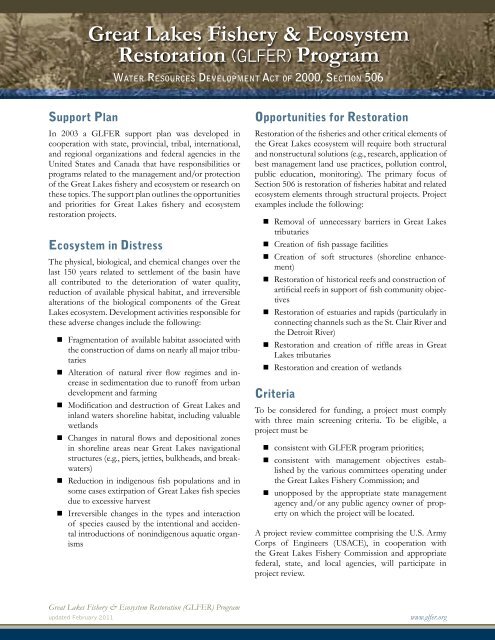Great Lakes Fishery and Ecosystem Restoration Program Project ...
Great Lakes Fishery and Ecosystem Restoration Program Project ...
Great Lakes Fishery and Ecosystem Restoration Program Project ...
Create successful ePaper yourself
Turn your PDF publications into a flip-book with our unique Google optimized e-Paper software.
Support Plan<br />
<strong>Great</strong> <strong>Lakes</strong> <strong>Fishery</strong> & <strong>Ecosystem</strong><br />
<strong>Restoration</strong> (GLFER) <strong>Program</strong><br />
In 2003 a GLFER support plan was developed in<br />
cooperation with state, provincial, tribal, international,<br />
<strong>and</strong> regional organizations <strong>and</strong> federal agencies in the<br />
United States <strong>and</strong> Canada that have responsibilities or<br />
programs related to the management <strong>and</strong>/or protection<br />
of the <strong>Great</strong> <strong>Lakes</strong> fishery <strong>and</strong> ecosystem or research on<br />
these topics. The support plan outlines the opportunities<br />
<strong>and</strong> priorities for <strong>Great</strong> <strong>Lakes</strong> fishery <strong>and</strong> ecosystem<br />
restoration projects.<br />
<strong>Ecosystem</strong> in Distress<br />
Water resources Development act of 2000, section 506<br />
The physical, biological, <strong>and</strong> chemical changes over the<br />
last 150 years related to settlement of the basin have<br />
all contributed to the deterioration of water quality,<br />
reduction of available physical habitat, <strong>and</strong> irreversible<br />
alterations of the biological components of the <strong>Great</strong><br />
<strong>Lakes</strong> ecosystem. Development activities responsible for<br />
these adverse changes include the following:<br />
n Fragmentation of available habitat associated with<br />
the construction of dams on nearly all major tributaries<br />
n Alteration of natural river flow regimes <strong>and</strong> increase<br />
in sedimentation due to runoff from urban<br />
development <strong>and</strong> farming<br />
n Modification <strong>and</strong> destruction of <strong>Great</strong> <strong>Lakes</strong> <strong>and</strong><br />
inl<strong>and</strong> waters shoreline habitat, including valuable<br />
wetl<strong>and</strong>s<br />
n Changes in natural flows <strong>and</strong> depositional zones<br />
in shoreline areas near <strong>Great</strong> <strong>Lakes</strong> navigational<br />
structures (e.g., piers, jetties, bulkheads, <strong>and</strong> breakwaters)<br />
n Reduction in indigenous fish populations <strong>and</strong> in<br />
some cases extirpation of <strong>Great</strong> <strong>Lakes</strong> fish species<br />
due to excessive harvest<br />
n Irreversible changes in the types <strong>and</strong> interaction<br />
of species caused by the intentional <strong>and</strong> accidental<br />
introductions of nonindigenous aquatic organisms<br />
Opportunities for <strong>Restoration</strong><br />
<strong>Restoration</strong> of the fisheries <strong>and</strong> other critical elements of<br />
the <strong>Great</strong> <strong>Lakes</strong> ecosystem will require both structural<br />
<strong>and</strong> nonstructural solutions (e.g., research, application of<br />
best management l<strong>and</strong> use practices, pollution control,<br />
public education, monitoring). The primary focus of<br />
Section 506 is restoration of fisheries habitat <strong>and</strong> related<br />
ecosystem elements through structural projects. <strong>Project</strong><br />
examples include the following:<br />
n Removal of unnecessary barriers in <strong>Great</strong> <strong>Lakes</strong><br />
tributaries<br />
n Creation of fish passage facilities<br />
n Creation of soft structures (shoreline enhancement)<br />
n <strong>Restoration</strong> of historical reefs <strong>and</strong> construction of<br />
artificial reefs in support of fish community objectives<br />
n <strong>Restoration</strong> of estuaries <strong>and</strong> rapids (particularly in<br />
connecting channels such as the St. Clair River <strong>and</strong><br />
the Detroit River)<br />
n <strong>Restoration</strong> <strong>and</strong> creation of riffle areas in <strong>Great</strong><br />
<strong>Lakes</strong> tributaries<br />
n <strong>Restoration</strong> <strong>and</strong> creation of wetl<strong>and</strong>s<br />
Criteria<br />
To be considered for funding, a project must comply<br />
with three main screening criteria. To be eligible, a<br />
project must be<br />
n consistent with GLFER program priorities;<br />
n consistent with management objectives established<br />
by the various committees operating under<br />
the <strong>Great</strong> <strong>Lakes</strong> <strong>Fishery</strong> Commission; <strong>and</strong><br />
n unopposed by the appropriate state management<br />
agency <strong>and</strong>/or any public agency owner of property<br />
on which the project will be located.<br />
A project review committee comprising the U.S. Army<br />
Corps of Engineers (USACE), in cooperation with<br />
the <strong>Great</strong> <strong>Lakes</strong> <strong>Fishery</strong> Commission <strong>and</strong> appropriate<br />
federal, state, <strong>and</strong> local agencies, will participate in<br />
project review.<br />
<strong>Great</strong> <strong>Lakes</strong> <strong>Fishery</strong> & <strong>Ecosystem</strong> <strong>Restoration</strong> (GLFER) <strong>Program</strong><br />
updated February 2011 www.glfer.org


